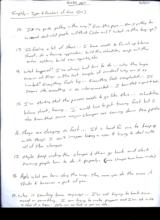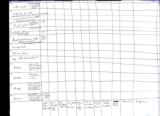|
Basic Assignments
|
Options & Settings
|
Main Time Information
|
||||||||||||||||||||||
|
|
|
|
|
|||||||||
|
|||||||||
|
|
|
Notes:
|
|
Simplify – Types and Functions of Time 1. There are 50 to 100 known types of time. Many are very similar, only what you call it needs to change. Almost like groups or families. Like values. 2. There are 50 to 100 known functions (needs) for time elements to play with. 3. Most people want things that are pre-set and ready to function out of the box. Other people want to be able to customize things. 4. If things are too hard to do, set-up, or maintain… you lost functionality because people are inherently lazy. K.I.S.S. 5. What is a standard? How do I play to that? 6. It needs to be as simple as possible. 7. What if we created basic templates (types and functions) and then allowed the user to apply a template to each time element. 8. What if every element of time was as simple as an id number, a corp, and a template id number. All other pieces would be subs according to the template (directions and requirements). At least one sub would be required but the element could have more than one. 9. What if the types were something like: personal (my), person(s), place(s), thing(s), combination, custom. 10. What if the functions were something like: date only, date/time, …. Infinity 11. Why am I scared to commit… I see that it is big; I see that people want to be able to call it this and that. I want to tie it all together, and part of me wants to keep it all under the same roof “elements of time”. 12. Is my pride getting in the way? Even this page… am I getting too worried about what people will think (later on)? What is the hang-up? 13. I’m feeling a lot of stress… I have needs to finish up balance sheet, do a training application, build the scheduler, map out the entire system, build new reports, etc. 14. What happened? I’ve always had tons to do… why the huge swarm of things in the last couple of months? Why am I so limited? Everything feels big… Everything feels complicated… It seems like everything is so interconnected… I know that is good and bad… 15. I’m thinking that the process needs to go like this… scheduling, balance sheet, and training. I would love to put training first but I also know that some major changes are coming down the pipeline. 16. Things are changing so fast… It is hard for me to keep up with things. I can’t imagine being a user and trying to deal with all of the changes. 17. Maybe keep making the changes and then go back and start training people how to do it properly. (Once changes have been made) 18. Apply what you learn along the way. The more you do the more it sticks and becomes a part of you. 19. Who is counting time anyway… I’m not trying to break some record or something. I am trying to make progress and I’m okay with a step at a time. Only run as fast as you are able. From a gridded outline for brainstorming “elements of time”; Needs – rows – 1,2,3… & Types of Time – columns – A, B, C… NEEDS - rows 1. Basics, quick name or title, corp, id, template, creator id, sub type 2. Date (day only, single, multi, range, reoccurring) 3. Category & sub category sort 4. Time (time only, n/a, single, multi, range, special rounded, reoccurring) 5. Total time 6. Notes & credits (real, practice, draft, concept – 255 or big) 7. Payroll 8. Privacy, show/hide, web, visible, permissions 9. Assignment(s) & changes (one or many), change log 10. Reminder(s) & notification(s) - sending messages and pushing reminders to main homepage 11. Photos & media – subs, choices, ftp, decisions, stitching, content… video, stills, graphs, maps, audio, html, pdf, word, etc. 12. Comments 13. Invoice tie-ins – details or summed up (invoice types), (invoiced, not invoiced, no charge), recipe tie-in (one to many) 14. Quick tie-ins (build or pull from multi chain as needed) 15. Financial & general amount – standalone declarations, able to add back up to the main (revenue, costs, value) 16. Sign-offs & by who? – maybe a 1-many (review, outside players – sharing) 17. Rate tables & look-ups – seasonal, promotion, sales 18. Expiration dates &/or show until dates – due or target dates 19. Booked vs. actual usage, planned vs. reality 20. GPS subs 21. Sub pool(s) – what kind in/out of play 22. Reoccurring (master/share, template, blocks, average unit, standards, slot, values) 23. Flex fields (names & types) 24. Tie-ins (flex grid, what else) what about tying together subs and media, sewing, stitching, links, groups 25. Customer (1 or many) look back, relationships to other tie-ins, roll call, participants, general or generic 26. Vendor/payee (1 or many) 27. Histories & usage logs – start, stop, # of times 28. Sub times or sub time frames – due dates, aging & queues (relationships) 29. Follow-up & details –progress reports 30. Finished/starting settings or completion – starting, prerequisites, requirements, test & evaluation 31. Rewards & promotions 32. Medical records 33. Capacity, min, max, optional 34. Deadlines, timelines, phases, grace periods, due dates, outlines, content, details 35. Status changes – edit mode, dynamic status lock down 36. eCommerce 37. Inter corp – security, settings (general, per corp, per user, IP address) 38. Back tie to units – this may be on the unit or a pool that the unit is assigned to 39. Cancel/back-out/void (see status), (make sure and cascade to subs) 40. Check in/out (start/stop, actual/rough) 41. Mass entry – recipes, packages, deals 42. Priority & rating 43. Reports & searching needs – capacity, conflicts, testing, history, usage, availability, booked, open/closed 44. Waiting list 45. Cleaning status 46. Fees (late, cleaning, other) 47. Person(s) – customer, vendor, payee, user, salesperson, N/A, party, unassigned, crews, lines, shifts 48. Place(s) – subs, temp, variable, multi, unassigned 49. Thing(s) – storage, units, parts, general or generic, assets, money, supplies, labor, overhead, shipping, sub-contractors, game 50. Dynamics – (fun & extras, names, titles, needs, html, multi-step, memory, colors, increments, webservices) Types of time – columns A. Lists, tasks, assignments B. Notes & reminders, progress reports C. Basic, scheduling & appointments D. Time sheets, time logs E. Sharing & collaboration F. Sales & promotion marketing G. Meetings & events, classes H. Projects, updates & newsletters I. Resorts & tabs J. Reservations K. Dispatching L. Registration M. Job costing, estimates, quotes & invoices N. Maintenance, manufacturing & production O. People, employees, techs, doctors, teachers, crews P. Invoices, e/r’s, bs: reoccurring or system-maintained Q. Goals & forecasting, (production, sales, general) R. Rentals, storage S. Places, rooms, locations, subs, main, #’s T. Things, stock/units, parts, general, pools U. Payments in/out, date due, deadlines & grace periods |







